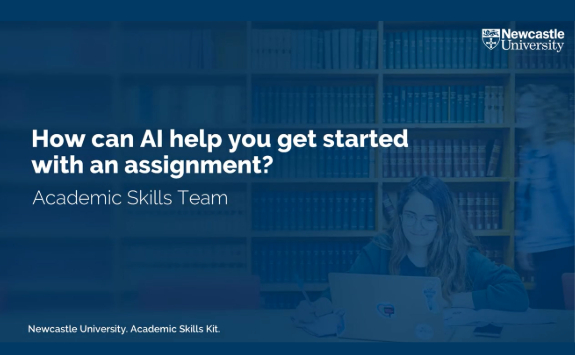Planning with AI
Working with Generative AI to talk through and clarify your ideas, plan your writing and help you get started.
Working with AI tools to plan and structure your work
Planning your work and your approach to the task is the first step of this process and AI tools can be a great digital assistant at this stage. Whilst you can’t submit AI-generated text as your own work, you can use AI tools to help you articulate your own ideas. When it’s used appropriately, AI can supplement your research and writing processes in a way that keeps your skills sharp and your integrity intact.
‘Planning’ covers the early stages of writing an assignment, from unpacking a question to the point where you’re ready to start drafting. It’s the part of the process where you start to generate and develop the ideas you’ll be communicating to your reader in the finished product and think about how these ideas might best be structured and evidenced.
Some ways Generative AI might help you with this process include:
- Explaining an unfamiliar idea or simplifying a complex idea to help you get started with your reading:
Please explain [x] in terms understandable to a non-expert
- Helping you schedule your assignment deadlines and other commitments:
Here is my to-do list with approximate timings and deadlines for each task:[…] Please help me create a schedule for the next three weeks. I want to work between 9am -5 pm and would like to include time for a short break every hour and a longer break twice a day.
- Generating writing prompts to help you process your reading, develop your ideas and/or get started with writing:
I am writing an essay about [x]. I want to argue [y]. Please ask me questions challenging this statement to help me develop my answer
Please suggest some writing prompts to help me get started with synthesising my research for my dissertation literature review
- Explaining the general structure of particular assignment types:
Please explain and give me an example of the structure of a scientific lab report
Watch the video below, for some tips from Matteo about how to work with AI to help you get started with an assignment.
Scope the topic
Scoping is an essential first step in keeping your work focused on the task or assignment you've been given and manageable. Scoping is developing your initial ideas and thoughts and defining what your work will cover. Here are some suggestions on how AI could help you with this stage and you'll find example prompts below too.
Choose your topic and focus areas
Use prompts to ask tools such as Copilot to tell you some basic themes around your topic, then use follow-on prompts to delve deeper, such as asking for case studies, real-world examples, or counterarguments. Approach the outputs critically and ask how the results relate to or build on your initial position. You might want to repeat this process for different sub-themes but remember to always evaluate the output and look beyond the information in front of you to ensure your source is credible (lateral reading). Used in this way, Generative AI can be a powerful tool to broaden your understanding and perspective of a research topic, and identify new areas to explore in more depth.
Set goals
Generative AI could suggest a list of potential objectives based on your topic allowing you to work to specific goals. Use follow-on prompts to narrow broad goals into specific, achievable ones. If AI generates too many objectives, prompt it to reduce or prioritise them according to importance.
Set boundaries
This is when you define the limits of your research, such as time, location, etc. You can ask Generative AI what it thinks you should include or exclude in your research which is your next step in planning.
Begin gathering information sources
In the early stages of an assignment you might need to ask yourself, is there enough information out there to support my plan? Generative AI can help you answer that question quickly by recommending information resources such as key authors, books, articles or website that are most relevant to your topic. This may help you gather some quick information to kickstart your reading. At the moment, Generative AI isn't the best way to source academic materials because the sources themelves are behind a log in, but you'll find AI functionality in lots of library databases, and some also have AI research assistants built in. Databases such as Semantic Scholar are also great to help you identify existing studies and what is already known on the topic.
Start to research the topic
Background research and scoping are closely linked. Thorough background research helps you define your approach, understand the context of your topic, and identify knowledge gaps that your assignment might highlight. Once the background research is in place, you will need to look further into reputable sources and the academic literature needed for your task.
Build your foundational knowledge
One of the real strengthts of Generative AI, and where it can be an invaluable research assistant, is at the point where you are building your knowledge foundation. As you start a new assignment task, ask yourself what you know already and where you may need to seek alternative informtion. Prompt tools such as Copilot to provide definitions, alternative explanations for tricky or unfamiliar concepts, simple summaries and background information on topics, terms, and theme.
Gap analysis
Depending on your assignment, you might need to look for gaps in existing research. You might find it useful to prompt AI tools to search across current research on your topic, and summarise the hot topics, helping you see where there are gaps. Generative AI tools such as Copilot, or more advanced tools such as Open AI's Deep Research can summarise studies and identify areas where research is missing, contradictory, or outdated. It's important though that the act of reading and research for your assignment are essential parts of the learning and assessment process so don't let AI tools overtake your own discovery work.
Using AI for scoping and background research is about getting you started, past the blank page, and inspiring you. AI should be used as a tool to assist and guide your research, not to replace your critical thinking and analysis.
Focussing your reading
Reading for an assignment can become an overwhelming task and you may therefore be tempted to use AI tools to generate your research for you. However, this can lead to significant issues with the quality of your work. Firstly, you have no way of knowing if the sources gathered by the AI are high-quality or even real. Secondly, reading at university is about a lot more than just gathering knowledge; it involves making connections between your reading and the question and synthesising different ideas, sources, and arguments. This is a process which allows you to develop your own thoughts on the topic and going through this process yourself helps to develop a confident voice when you express these ideas in your assignments.
Generative AI tools can, however, be effective in helping to make some of the decisions that will help you to streamline and manage the reading process. For example, you might ask the AI to:
- Suggest an initial list of topics or questions to investigate to help decide what texts to read first and provide a focus for your reading:
I am investigating the importance of critical thinking to undergraduate-level study. Please suggest five questions to help me get started with researching this topic
- Summarise the key points of an article to help you decide which parts to read in more depth:
Please give me an outline of the structure of this paper and the key points it covers
- Define unfamiliar terms and/or rephrase difficult sentences:
Please simplify this sentence for a non-expert reader
In all of these cases, Generative AI is being used to support, rather than replace, your own reading. This allows you to still engage with others’ ideas in a way that will help develop your own skills and understanding of the topic whilst taking a more focussed approach to what you choose to read and how you read it.
Develop your ideas and plan a structure
It’s important to keep in mind that a lot of planning activities are focussed on developing your own ideas and responses to the question you’ve been set. Therefore, you’ll need to be careful to ensure that you are using AI tools to help you work through this process, rather than asking them to do the work for you to ensure that academic integrity is maintained and produce high quality work.
For example, you may wish to use Generative AI to help you to structure your work. However, simply putting your question into an AI tool and asking it to create a structure would be inappropriate and/or ineffective for several reasons. Firstly, structure and content go hand-in-hand; to come up with a structure the AI would also have to generate, or at least influence, some of the content you include, meaning that the finished product is not your own. Secondly, the AI cannot perform higher-order thinking as effectively as you can. It hasn’t been to the lectures on the module or read and evaluated the same literature you have and therefore the work it produces will likely be far more generic and superficial than your markers are expecting.
A more effective way to use AI for planning and developing your work is to treat it as a ‘critical friend’. Think of your work as a ‘conversation’ between you and your reader where you unpack and explain your arguments by answering the questions they might have about them. You might therefore use Generative AI as a partner in a Q&A to help you imagine what these questions might be and what order a reader might ask them in. For example:
Prompt:
I am writing an essay arguing that critical thinking is the most significant feature that distinguishes UK undergraduate-level study from previous levels of study. Imagine you are my reader. What is the first question you have about this stance?
AI answer:
The first question I have is: “How do you define "critical thinking" in the context of UK undergraduate study?
Prompt:
My answer would be that critical thinking has multiple definitions depending upon the subject and/or context but that common to all of them is 'doing something' with knowledge, information and ideas, rather than describing it. This is what makes it different from earlier levels of education. What would your next question be?
AI answer:
Can you provide specific examples of how critical thinking is expected or assessed differently at the undergraduate level compared to earlier education?
As you can see, using AI in this way prompts you to think about how you might answer these questions, helping you to develop your thinking and get a clearer sense of the points you want to make. You can also get a sense of what order these points might come in.
Bear in mind that not all of the questions suggested by the AI will be relevant to the question and/or to what you want to include in your work. Here, Generative AI is a starting point but you’ll still need to make your own decisions and be ‘in control’ of the final plan to ensure that it does what you need it to and that it takes into account any guidance you’ve been given about structure in the assignment brief. It is also important to ensure that you include a statement with your submission acknowledging your use of AI.

